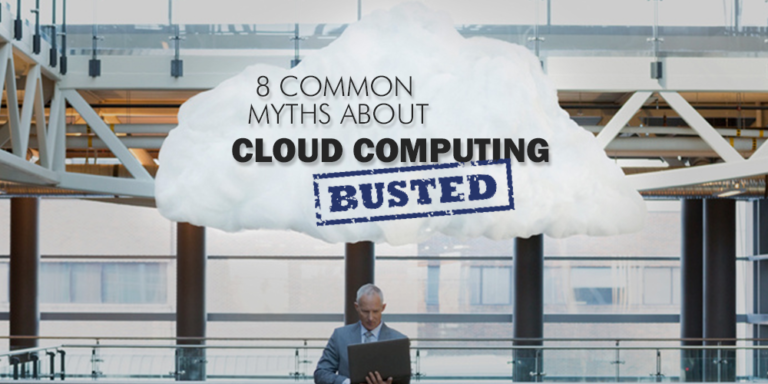A major business driver today, there’s more to the cloud than the over-hyped issue regarding its safety. Getting a cloud technology associate certification will easily let you in on the huge impact the cloud has on all types of businesses and debunk misinformation that result to myths about deploying and running applications in the cloud. These misconstrued facts impede innovation and instill unnecessary fear among CEOs, hindering them from using a possible technological advancement that can be key to progress.
Despite the globally agreed upon formal definition of the cloud, multiple perspectives and agendas continue to mystify the subject matter even more. Here, we list down the cloud security myths that continue to circulate and provide the real information you need to make an informed decision for your business.
What you'll find in this article [hide]
- 1 Myth 1: The cloud is inherently insecure.
- 2 Myth 2: It’s cheaper to run on cloud.
- 3 Myth 3: Everything can be automated on cloud. There is no need for support.
- 4 Myth 4: The cloud costs jobs.
- 5 Myth 5: You can ignore Bring Your Own Device (BYOD) and be more secure.
- 6 Myth 6: Shifting to cloud is a hassle and not worth it.
- 7 Myth 7: The cloud can damage the environment.
- 8 Myth 8: Cloud technology is still in its early phase.
Myth 1: The cloud is inherently insecure.
Perhaps the top myth that has to die is that data is not secure in the cloud. There is no doubt that security is important. Data breach and leaks are notorious for bringing down sites and losing companies valuable revenue at the cost of their reputation. It is not appalling to that security concerns remain at the forefront of the factors inhibiting CEOs from considering operating on cloud. But this is also one of the biggest myths surrounding cloud.
The truth is that the risks are the same as those faced by traditional IT solutions. The main difference is that when operating on cloud, security is not a company’s lone burden but a shared responsibility with its cloud hosting provider. That being said, a good provider must have multiple security measures in place—from dedicated firewalls and up-to-date encryption to intrusion detection systems and accredited data centers.
Myth 2: It’s cheaper to run on cloud.
It is not cheaper to run on cloud but rather more cost efficient. If it’s necessary for your servers to run 24/7 the whole year round, chances are you’ll get the same compute power cheaper using the same dedicated server. The best thing about the cloud is that it answers to varying demands and workload. It also enables companies to switch servers off during lower demand periods to limit infrastructure costs. This automatically improves cost efficiency by matching cost pattern to revenue pattern.
Myth 3: Everything can be automated on cloud. There is no need for support.
The great thing about the cloud is that everything can be automated from the infrastructure layer upwards. This, of course, does not require expertise of the tools involved. For an app developer designing from scratch to run on the cloud, automation is easy, enabling auto scaling and self-healing with no need for human intervention at all. However, if you do not have this level of knowledge and expertise then it is likely that you will need additional support, at least for the short term.
Myth 4: The cloud costs jobs.
There is no correlation between IT resources and the cloud. The reality is that the increasing shift to the cloud will require a host of cloud experts whose skills and savvy will be needed to maintain and strengthen its growth and development.
Myth 5: You can ignore Bring Your Own Device (BYOD) and be more secure.
The BOYD movement is here to stay. Non-support of it and implementing policy on it does not mean a company will be at less risk of data breach. Deploying a mobile content management solution (MCM) because protecting the data will ultimately define a business’ security and compliance requirements.
Myth 6: Shifting to cloud is a hassle and not worth it.
While the cleaning and architectural issue may be required especially if a company’s working on old servers, migrating to cloud should be hassle-free if you have a trusted and experienced hosting provider. It is possible to make the shift quickly and smoothly with minimal downtime. The intermittent inconvenience cannot outweigh the long-term benefits of the greater efficiency, cost effectiveness of a future-proofed business.
Myth 7: The cloud can damage the environment.
In reality, cloud computing is the way to go green. On-site data centres use about twice as much power than is actually needed once cooling, lighting and maintenance are factored into the equation. In contrast, hosting with a provider delivers the very latest in power-efficient technology.
Myth 8: Cloud technology is still in its early phase.
Better think twice about this fallacy. A recent ISACA study revealed that cloud computing is fast approaching maturity. The next four years will witness the constant innovation at an ever increasing pace and continued refinement which will ensure cloud computing meets the needs of every size and type of business. Those that have shifted to cloud will most likely reap the long term rewards.
In conclusion, dwelling on the myths surrounding the cloud will only prevent your organization from realizing the benefits. Cloud computing is an opportunity to minimize financial risk for a net-new project or investment. Part of overcoming the fears of the cloud is knowing what is real and not when you make that move.



